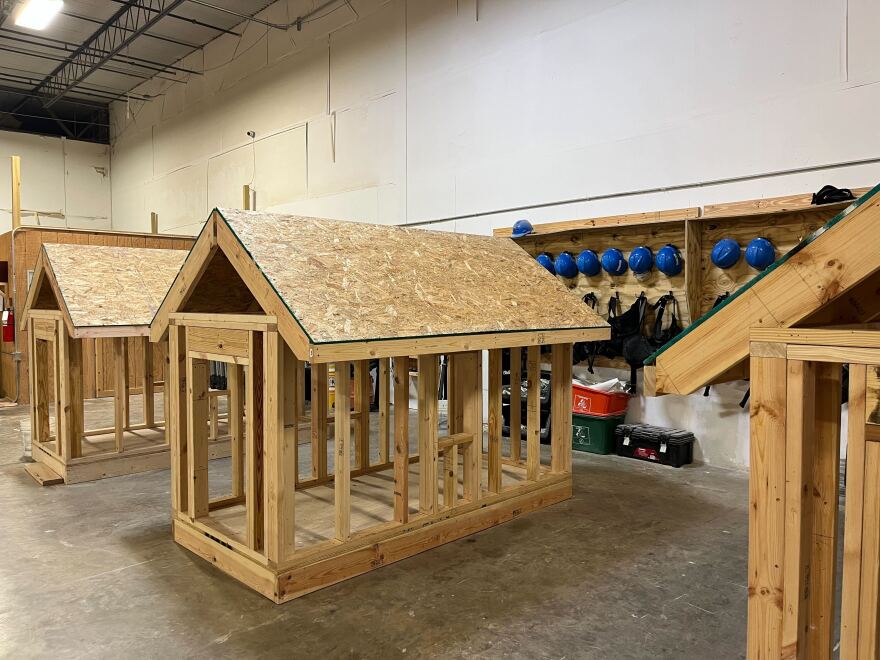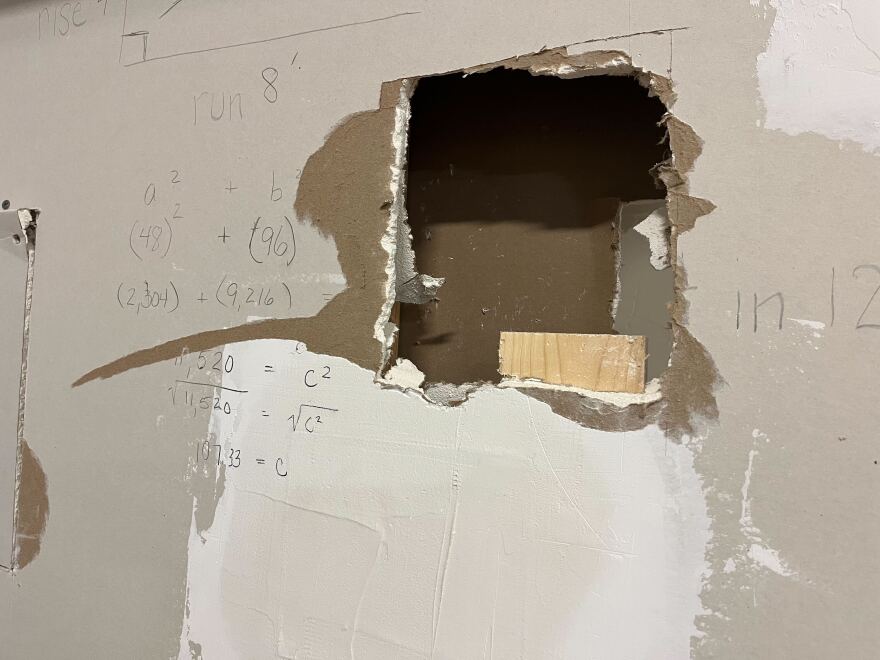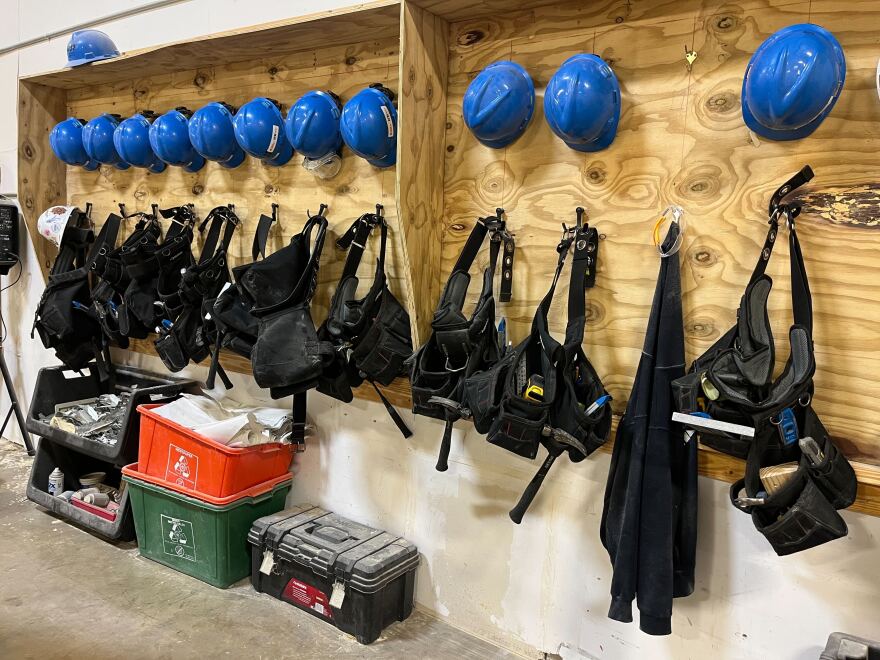It can take years to clean up and repair a home in Florida after a natural disaster like a hurricane. This is only made worse by a shortage of construction workers in the state.
Central Florida Public Media visited a program training veterans to help with home rebuilds after the storms. It’s made possible through a partnership between the Home Builders Institute and veterans nonprofit Team Rubicon.
Veterans train to help rebuild after storms
Tim Zander was in the military for nine years. When he left, he was looking for structure and a way to give back. He found it in carpentry.

“It's always been in the back of my mind. My grandpa was a carpenter. I’ve always enjoyed working with my hands,” Zander said.
But it was Zander’s wife who encouraged him to train up to become a carpenter and enroll in the free nine-week carpentry and roofing training program offered by the Home Builders Institute and Team Rubicon. Zander had already been helping friends and family members out with repairs around the house.
“My wife, she's a veteran too. She talked to me about it and said, you know, you should just go for it,” Zander said.
Zander and his cohort of 14 will graduate November 21. Each student will get an OSHA certificate, an important trade certification, and help finding an apprenticeship and a job. Zander said he’s ready to help his community once he completes the program.
And that, according to Home Builders Institute's Associate Vice President of Academies Alex Gomez, is the goal.
The training begins
The program Zander enrolled in is in its first year. The goal: to help veterans with the transition back to civilian life, while producing workers who can help repair and rebuild homes after natural disasters.
Gomez said veterans learn the basics of carpentry and roofing, and review the math needed to be successful during the first few weeks of the program.

“In the first week, we call that an intro, the intro class or intro level. They get a certificate at the end of the intro. They learn about tool identification. They learn about basic math, because they got to know how to use a tape measure, and they got to know how to use decimals and multiplication, addition, and need to know how to measure twice, cut once,” Gomez said.
Then Gomez said, students learn how to build hurricane resilient homes using smaller models of homes and roofs in a shop.
“So throughout the whole nine weeks, they do 20% of that time in the classroom, and about 80% of that in the shop,” Gomez said. “They're going to actually learn how to build out a roof, lay down the tiles and how to make them fortified so that it can withstand the winds of a hurricane over 150 mph. So it's all hands on. And these are instructors that are industry trained, that have been in the field for 20 plus years.”

When they leave the program, students can walk directly into an apprenticeship and a job in construction. That’s crucial as there’s a shortage of these workers in Florida.
A shortage of skilled trades workers
According to trade association Associated Builders and Contractors, Florida is short more than 400,000 construction workers this year alone.
A recent analysis of Bureau of Labor Statistics data, found Brevard County, in Central Florida, came in fourth place in a roundup of Florida counties losing the most construction workers to early retirement or other reasons. Brevard lost 8.96% of its skilled workers between the first quarter of last year, and the first quarter of this year.

An aging workforce, low pay, dangerous work conditions and an uptick in immigration enforcement in the state are to blame for this shortage of workers.
Florida College Access Network’s Dave Sobush said there’s more students going into the skilled trades in Florida, but not enough to make up for everyone leaving the industry. Skilled trades workers need to complete apprenticeships, which can take 3 to 4 years to finish. Apprentices also start out making a lower salary and have to pay for tools and other materials.
Sobush said that can be a turn-off for students and families who might opt instead for a higher-paying job directly out of high school.
“There is always the opportunity of, you know, I could go work in a warehouse for $23 to $24 dollars an hour right now, as opposed to putting in the time. So there's some macro-economic challenges to some of these decisions that are made,” Sobush said.
Sobush says that’s why programs like the one Zander and the other veterans are doing is great. The program is completely free, everything from tools to textbooks are included, and students can walk directly into an apprenticeship and job.

Sobush said here’s the reality: jobs in every industry will require training moving forward, including in the trades. Better to make the commitment now, that will pay off later, than winging it without anything other than a high school diploma or GED.
“You don't necessarily walk off the graduation stage and into the foreman's office the following day,” Sobush said. “Jobs require training beyond high school, and sometimes that training occurs in conjunction with high school. Whether it's dual enrollment, career dual enrollment, that students do at the same time they're taking their high school courses, but many times, and especially for our skilled trades, it is in the form of an apprenticeship, which is a partnership between an employer and a sponsoring entity.”
Sobush said the DeSantis administration has placed an emphasis on workforce training and education programs.
According to the Florida Department of Education, $105 million has been awarded to high schools and colleges preparing students for a career in the trades through the Florida Pathways to Career Opportunities Grant.
The governor has committed more than $10 billion to workforce education and training in his two terms in office. In Florida, there are nearly 800,000 K-12 career and technical education students and 22,444 registered apprentices and pre-apprentices.
But some experts warn it’s not enough.
Hurricane repairs slow down
Seminole County Emergency Manager Alan Harris says if a shortage of construction workers isn't fixed now, it will make wait times for home repairs after hurricanes even longer. In Seminole, people were impacted by Hurricane Milton last year, and a tornado and flooding events this year, making it hard to recover.

“So we haven't had a hurricane this year, but we have had some tropical waves that have come through, that have provided us a lot of water. We've been in a minor flood stage a couple times already this year. Earlier in the year, we had an EF-2 tornado, one of the stronger tornadoes to hit Seminole County in the last couple decades. So that created additional work on top of the work that was already taking place from Hurricane Ian in 2022,” Harris said. “So people are still recovering from Ian, not even to talk about Milton last year, but Ian and Nicole back in 2022.”
Harris said in 2025, it’s not just a shortage of construction workers that’s causing delays in home repairs and rebuilds. It’s other factors too: including a shortage of federal workers and rising tariffs on building supplies and materials.
“There are supply chain issues, certainly, things are more expensive now due to the tariffs and the uncertainty that's out there, as well as there were some serious delays. With the federal government laying off employees and stuff like that, there aren’t as many FEMA employees to review the applications and plans that there were previously,” Harris said. “So there aren't as many people. That delayed projects up to about a year in some cases. While these are three-year projects, you delay it a year. Now it's a four-year project. So some of these will not be completed until 2029, 2030.”
Back at the Home Builders Institute in Orlando, veteran and student Tim Zander said there’s nothing else he’d rather be doing.
“I would say it’s in my blood,” Zander said. Plus, the fact he’s really good at math, the basis for all construction projects, doesn’t hurt either.
To learn more about the program, click here.





